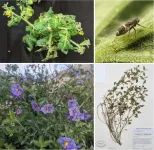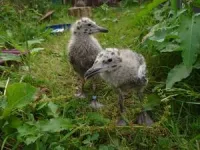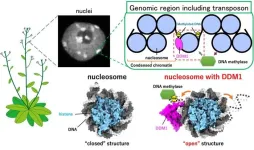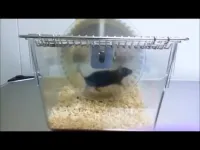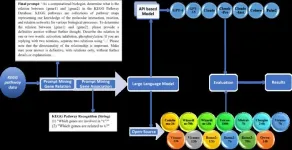(Press-News.org) Native plants and non-native crops do not fare well in proximity to one another, attracting pests that spread diseases in both directions, according to two new UC Riverside studies.
“We have changed the landscape, and it’s created opportunities for pathogens to thrive,” said UCR entomologist Kerry Mauck, who co-authored the studies. “We have introduced pathogens that damage native plants, and on the other side of the coin we have endemic pathogens that mutate to infect crops.”
Illustrating the latter scenario, a new paper in the journal Phytopathology documents the presence in wild California plants of a bacterial pathogen affecting nightshade plants like tomatoes, potatoes, and peppers.
The pathogen, Candidatus liberibacter solanacearum or CLso, is related to the pathogen that causes citrus greening disease, a disease that kills citrus plants and for which there is no cure. Like citrus greening, CLso is transmitted to plants by a small flying insect called a psyllid.
CLso causes a potato disease called zebra chip which deforms the tubers, making them unmarketable and reducing crop yields by up to 90%. It first appeared in the 2000s and quickly spread throughout the country.
“We wanted to know, why did this thing show up so suddenly in the U.S.? The psyllid vector has been here. It’s native. We wondered if maybe the pathogen has also been here longer than we realized,” Mauck said.
To answer this question, the research team visited various UC natural reserves, a network of wildland areas managed for academic use. They took samples of plants in the nightshade family from each location they visited, and also looked at preserved herbarium specimens dating back to the 1970s.
The pathogen was present in 15-20% of the plants they examined, but the forms of it they found are not known to infect crops. Furthermore, the wild form of the pathogen isn’t known to harm the plants it inhabits. However, the form that affects crops does cause disease.
In other words, the CLso variants found in wild plant communities are not spilling over into agricultural fields. The researchers recently received funding from the U.S. Department of Agriculture to understand on a molecular level what changed as the pathogen mutated to be able to infect crop plants.
“What has changed to make this pathogen emerge as problematic? What proteins are different in the benign and virulent variants? What do they interact with in the plant? If we learn the answers to these questions, we can understand how plants resist the disease, and help them,” Mauck said.
In a related study, published in the Phytobiomes Journal, Mauck and colleagues studied the possible movement of viral pathogens from agricultural fields to wild squash plants in the UC reserves.
“Crops such as squash, melons, and potatoes attract aphids and whiteflies that can spread viruses from crops to wild plants,” Mauck said.
“A lot of the viruses in crops are very new to the area, being introduced only in the last couple of decades. If these viruses are moving out of crops and into wild areas, the native plants could be bombarded with new pathogens they’ve never encountered before.”
For this project, the researchers again sampled plants from the UC reserves as well as Anza-Borrego Desert State Park. Fully 80% of the wild squash plants they sampled were infected with a virus that is not native to California called cucurbit aphid-borne yellows virus, or CABYV.
When the researchers studied these viral infections, they found that CABYV inhibits the growth of plant roots — a problem for environments that are especially dry and hot in summer like Southern California.
“If the plants can’t make roots, they can’t access groundwater or store water in their roots. And wild squash are among the few plant species growing and providing resources in summer, so they’re relied on a lot by other organisms,” Mauck said. “They’re highways for ants. They provide nectar and pollen. The seeds are eaten by endangered mammals. They’re critical.”
The researchers feel both studies underscore the importance of land managers, growers, and plant enthusiasts working together to reduce the introduction of plant pathogens to new spaces.
“Plant pathogens can be anywhere. Whenever we move plants for trade, there is the potential for bringing in pathogen hitchhikers as well. We need to make sure we’re moving only plant material that doesn’t contain these unwanted guests,” Mauck said.
“Studying how plant pathogens move, live together in plants, and mutate over time can help us to achieve the goal of reducing unwanted pathogen problems both in crops and in wild plants.”
END
Wild plants and crops don’t make great neighbors
Pathogens spill from one population to the other
2024-07-11
ELSE PRESS RELEASES FROM THIS DATE:
Movement sensors show promise in identifying horses at injury risk
2024-07-11
PULLMAN, Wash. – A small 3-ounce sensor capable of recording 2,400 data points of movement in just one second being tested and refined by researchers at Washington State University could be key in reducing the number of injuries to racehorses.
Led by Dr. Warwick Bayly in WSU’s College of Veterinary Medicine, researchers used the biometric sensors, developed by the company StrideSAFE, to track thoroughbreds as they raced and trained at some of the top racetracks in the country. Using collected data, the team was able to identify miniscule stride changes associated with increased risk ...
Opening the right doors: “jumping gene” control mechanisms revealed
2024-07-11
International joint research led by Akihisa Osakabe and Yoshimasa Takizawa of the University of Tokyo has clarified the molecular mechanisms in thale cresses (Arabidopsis thaliana) by which the DDM1 (Decreased in DNA Methylation 1) protein prevents the transcription of “jumping genes.” DDM1 makes “jumping genes” more accessible for transcription-suppressing chemical marks to be deposited. Because a variant of this protein exists in humans, the discovery provides insight into genetic conditions caused by such “jumping gene” mutations. The findings ...
Blood fat profiles confirm health benefits of replacing butter with high-quality plant oils
2024-07-11
Switching from a diet high in saturated animal fats to one rich in plant-based unsaturated fats affects the fat composition in the blood, which in turn influences long-term disease risk. A recent study published in Nature Medicine, conducted by a team of researchers from Chalmers University of Technology, Sweden, the German Institute of Human Nutrition, Germany and several other universities, shows that it is possible to accurately measure diet-related fat changes in the blood and directly link them to the risk of developing cardiovascular disease and type 2 diabetes.
“Our study confirms with even more certainty the health benefits of ...
Air pollution harms pollinators more than pests, study finds
2024-07-11
Bees and other beneficial bugs are disproportionately harmed by air pollution compared to crop-destroying pests, a new study published in Nature Communications has found.
Researchers from the University of Reading analysed data from 120 scientific papers to understand how 40 types of insects in 19 countries respond to air pollutants like ozone, nitrogen oxides, sulfur dioxide and particulate matter. Pollinators - including bees and some moths and butterflies - experienced a 39% decline in foraging ...
Aperiodic approximants for relating quasicrystals and modulated structures
2024-07-11
For a long time, scientists associated crystal structures with an ordered arrangement of atoms in a repeating lattice-like pattern, believing it to be the most stable configuration. However, by the 1960s, advancements in crystallography revealed materials that did not fit the traditional model. These structures exhibit a non-periodic or non-repeating pattern and are called aperiodic crystals.
There are two types of aperiodic crystals: quasicrystals (QCs), which exhibit ordered but aperiodic arrangements, and incommensurately (IC) modulated structures, where a three-dimensional periodic lattice structure ...
Hydrogen flight looks ready for take-off with new advances
2024-07-11
The possibility of hydrogen-powered flight means greater opportunities for fossil-free travel, and the technological advances to make this happen are moving fast. New studies from Chalmers University of Technology, in Sweden, show that almost all air travel within a 750-mile radius (1200 km) could be made with hydrogen-powered aircraft by 2045, and with a novel heat exchanger currently in development, this range could be even further.
“If everything falls into place, the commercialisation of hydrogen flight can go really fast now. As early as 2028, the first commercial hydrogen flights in Sweden could be in the air," says Tomas Grönstedt, Professor at Chalmers ...
Same workout, different weight loss: Signal molecule versions are key
2024-07-11
Some people lose weight slower than others after workouts, and a Kobe University research team found a reason. They studied what happens to mice that cannot produce signal molecules that respond specifically to short-term exercise and regulate the body’s energy metabolism. These mice consume less oxygen during workouts, burn less fat and are thus also more susceptible to gaining weight. Since the team found this connection also in humans, the newly gained knowledge of this mechanism might provide a pathway for treating obesity.
It is well known that exercise leads to the ...
Trained peers are as effective as clinical social workers in reducing opioid overdose, new trial finds
2024-07-11
In Rhode Island, USA, over one in four emergency department (ED) patients at high risk of overdose has a non-fatal opioid overdose in the 18 months post-discharge. A parallel, two-arm, randomized controlled trial conducted in Rhode Island of over 600 ED patients at high risk of opioid overdose found that support from a peer recovery support specialist (a trained support worker with lived experience of addiction) was as effective in reducing opioid overdose as support from a licensed clinical social worker. In other words, interviewing and intervention techniques informed by lived ...
Study: Algorithms used by universities to predict student success may be racially biased
2024-07-11
Washington, July 11, 2024—Predictive algorithms commonly used by colleges and universities to determine whether students will be successful may be racially biased against Black and Hispanic students, according to new research published today in AERA Open, a peer-reviewed journal of the American Educational Research Association. The study—conducted by Denisa Gándara (University of Texas at Austin), Hadis Anahideh (University of Illinois Chicago), Matthew Ison (Northern Illinois University), and Lorenzo Picchiarini (University of Illinois Chicago)—found ...
Comprehensive evaluation of large language models in mining gene relations and pathway knowledge
2024-07-11
Understanding complex biological pathways, such as gene-gene interactions and gene regulatory networks, is crucial for exploring disease mechanisms and advancing drug development. However, manual literature curation of these pathways cannot keep pace with the exponential growth of discoveries. Large-scale language models (LLMs) trained on extensive text corpora contain rich biological information and can be leveraged as a biological knowledge graph for pathway curation.
Recently, Quantitative Biology published a study titled "A Comprehensive ...
LAST 30 PRESS RELEASES:
Numbers in our sights affect how we perceive space
SIMJ announces global collaborative book project in commemoration of its 75th anniversary
Air pollution exposure and birth weight
Obstructive sleep apnea risk and mental health conditions among older adults
How talking slows eye movements behind the wheel
The Ceramic Society of Japan’s Oxoate Ceramics Research Association launches new international book project
Heart-brain connection: international study reveals the role of the vagus nerve in keeping the heart young
Researchers identify Rb1 as a predictive biomarker for a new therapeutic strategy in some breast cancers
Survey reveals ethical gaps slowing AI adoption in pediatric surgery
Stimulant ADHD medications work differently than thought
AI overestimates how smart people are, according to HSE economists
HSE researchers create genome-wide map of quadruplexes
Scientists boost cell "powerhouses" to burn more calories
Automatic label checking: The missing step in making reliable medical AI
Low daily alcohol intake linked to 50% heightened mouth cancer risk in India
American Meteorological Society announces Rick Spinrad as 2026 President-Elect
Biomass-based carbon capture spotlighted in newly released global climate webinar recording
Illuminating invisible nano pollutants: advanced bioimaging tracks the full journey of emerging nanoscale contaminants in living systems
How does age affect recovery from spinal cord injury?
Novel AI tool offers prognosis for patients with head and neck cancer
Fathers’ microplastic exposure tied to their children’s metabolic problems
Research validates laboratory model for studying high-grade serous ovarian cancer
SIR 2026 delivers transformative breakthroughs in minimally invasive medicine to improve patient care
Stem Cell Reports most downloaded papers of 2025 highlight the breadth and impact of stem cell research
Oxford-led study estimates NHS spends around 3% of its primary and secondary care budget on the health impacts of heat and cold in England
A researcher’s long quest leads to a smart composite breakthrough
Urban wild bees act as “microbial sensors” of city health.
New study finds where you live affects recovery after a hip fracture
Forecasting the impact of fully automated vehicle adoption on US road traffic injuries
Alcohol-related hospitalizations from 2016 to 2022
[Press-News.org] Wild plants and crops don’t make great neighborsPathogens spill from one population to the other

